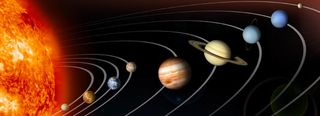
NASA will unveil plans for a new science mission to another world today (May 25).
The announcement will come during a teleconference with reporters at 4:30 p.m. EDT (2030 GMT). So far, NASA have given few other details, except to say in a statement that the future mission "will usher in a new era in planetary exploration."
It's possible that the agency has selected the next robotic exploration mission for its so-called Discovery Program, which is scheduled to launch around 2016.
Discovery missions explore the solar system on the relative cheap; the 2016 mission will have a fixed budget of $425 million, not including the cost of the launch vehicle. Earlier this month, NASA announced that it had whittled the contenders for that mission down to three finalists.
Those three are:
- The Geophysical Monitoring Station (GEMS), which would study the structure and composition of the interior of Mars, potentially improving our understanding of the formation and evolution of terrestrial planets;
- The Titan Mare Explorer (TiME), which would land in and float on a large methane-ethane sea on Saturn's moon Titan, providing the first direct exploration of an ocean beyond Earth; [Video: Targeting Saturn's Moon Titan: Land, Sea and Air]
- Comet Hopper, which would land on a comet multiple times and observe its changes as it interacts with the sun.
The shortlisting of these three came just two months after the release of an in-depth report from the National Research Council about the greatest needs for planetary exploration in the next decade.
The review had good things to say about the Discovery Program and its low-cost, highly focused planetary science. The report recommended maintaining the program's funding, with adjustments for inflation.
Get the Space.com Newsletter
Breaking space news, the latest updates on rocket launches, skywatching events and more!
Discovery efforts currently operating include NASA's Messenger mission to Mercury and the asteroid-chasing Dawn mission.
You can follow SPACE.com senior writer Mike Wall on Twitter: @michaeldwall. Follow SPACE.com for the latest in space science and exploration news on Twitter @Spacedotcomand on Facebook.
Join our Space Forums to keep talking space on the latest missions, night sky and more! And if you have a news tip, correction or comment, let us know at: community@space.com.

Michael Wall is a Senior Space Writer with Space.com and joined the team in 2010. He primarily covers exoplanets, spaceflight and military space, but has been known to dabble in the space art beat. His book about the search for alien life, "Out There," was published on Nov. 13, 2018. Before becoming a science writer, Michael worked as a herpetologist and wildlife biologist. He has a Ph.D. in evolutionary biology from the University of Sydney, Australia, a bachelor's degree from the University of Arizona, and a graduate certificate in science writing from the University of California, Santa Cruz. To find out what his latest project is, you can follow Michael on Twitter.
